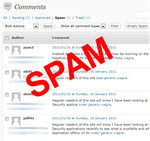If you have done any ring time on the blogosphere, you already recognize the title “Very nice post I certainly love this website keep on it.” This is a statement that many bloggers find filling up their inboxes no matter what they do. (If I had a dime for every one of these...) In fact, some companies actually outsource the spamming as a job throughout parts of Asia. They’re paid per accepted comment, but because they have to move such high volume per hour, they never take the time to read the post. Instead, they endlessly type generic things like (you guessed it), “Very nice post, I certainly love this website...”
Ranking Means Everything
Major search engines are becoming the most dominating force in the digital world, and ranking means everything, even when it comes to commercial online distributors. Companies will spare no expense, some cutting every corner possible, just to inch up the page hoping for more clicks and sales.
As outbound marketing has become less popular on the web, the spam comments aren’t working as well anymore. Programs to block these types of unwanted comments are popping up all the time, almost forcing spammers to actually (God forbid) read the article, and then comment appropriately.
Of course, what spammers and the people who pay them are really after is a physical link, a backlink to their site which gives them more credence in the eyes of Google or Bing search engines.
Here are three reasons why generic blog commenting is bad:
- Major search engines like Google are really beginning to crack down on bad or spammy links. For bloggers this could actually mean that their sites get penalized for having spam on their site, and even if the link is left sitting, it could look spammy enough to induce a penalty to the receiving site that actually paid for it.
- When people are browsing the net, spammy links under an article or blog show a lack of professionalism, and also a lack of moderation. Neither goes over well, and both reduce the effectiveness of blogs. The presence of spam tells people that there is no one taking care of the site or blog and cleaning away the unwanted digital debris.
- With comment spam, readers tend to lose faith and drop away. Additionally, they will be far less likely to comment themselves, not wanted to be seen in the midst of spam.
Take the title example, “Very nice post, I certainly love this website, keep on it.” It is general enough to fit anywhere and on any site; there’s no specificity. Spam comments try to sound legitimate without mentioning anything about the actual content of the blog or article, because the poster is not reading before commenting. In fact, often times it could be an automated process.
They think if they play by the numbers and spam enough comments like these, a few comments will make it through. The best thing for any blogger is to get protective software, or take the time to occasionally rid the sites of all generic comments and unwanted spam.




